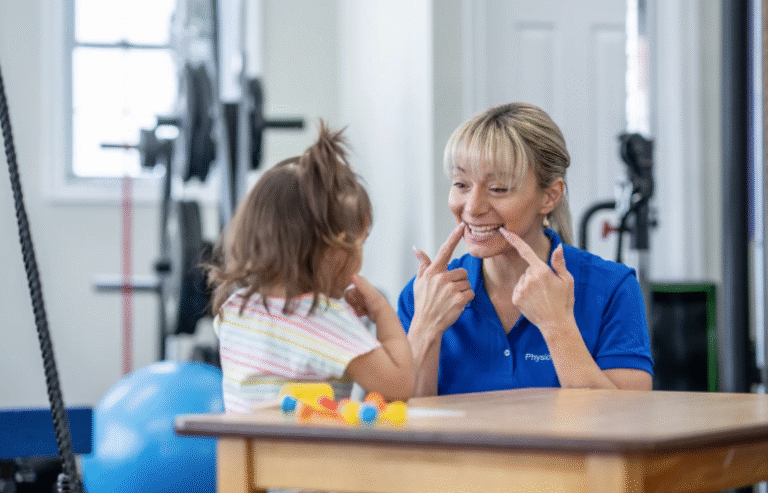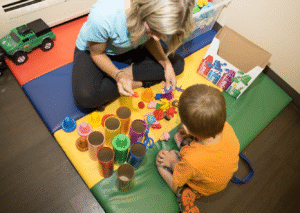Supporting Every Voice—Verbal, Nonverbal, and Everything in Between
At Crawl Walk Jump Run Therapy Clinic, we understand that communication is deeply personal. It’s how we express our needs, connect with others, share ideas, and navigate the world. But for many children and adults with developmental or neurological conditions, the road to communication can look very different from what we typically expect.
Communication doesn’t have to be verbal to be meaningful. It might be a gesture, a sound, a glance, or a tap on a screen. Every method of communication deserves to be recognized, nurtured, and celebrated. That’s where speech therapy comes in.
Understanding What Communication Can Look Like
When most people think of “communication,” they think of spoken language. But in reality, communication is a rich tapestry of behaviors, tools, and interactions. For individuals who don’t speak or who speak minimally, communication might include:
- Gestures or sign language
- Facial expressions and body language
- Picture Exchange Communication System (PECS)
- Augmentative and Alternative Communication (AAC) devices, like speech-generating tablets
- Vocalizations, approximations, or sounds
- Eye gaze or pointing
- Writing, drawing, or using symbols
These aren’t “lesser” forms of communication—they’re valid, essential, and effective. Speech-language pathologists (SLPs) help individuals and families discover which methods work best for their needs, empowering each person to share their world in their own way.
When Verbal Speech Isn’t the First Step
Children and adults may experience challenges with spoken language due to a variety of conditions, including:
- Autism Spectrum Disorder (ASD)
- Childhood apraxia of speech
- Genetic syndromes
- Traumatic brain injuries
- Cerebral palsy
- Hearing loss
- Developmental delays
For these individuals, communication might begin with foundational skills such as making eye contact, imitating sounds or gestures, or taking turns. These early interactions lay the groundwork for deeper communication, whether verbal speech eventually emerges or not.
At Crawl Walk Jump Run, we know that every step is meaningful. Saying “hi” with a wave, tapping a picture to request a snack, or learning to make a choice—these are milestones worth celebrating.
How Speech Therapy Supports Communication Growth
Speech therapy is about so much more than pronunciation. It’s about building a system of communication that works for the individual. SLPs begin with a comprehensive evaluation to understand strengths, challenges, preferences, and goals.
From there, therapy may focus on:
Language Development
We help clients understand and use words, whether through spoken language, pictures, or devices. Language therapy often includes building vocabulary, learning sentence structure, and developing comprehension skills.
Speech Clarity
When a child struggles with articulation or phonological patterns, therapy can help improve how clearly they speak. This may involve working on specific sounds, breath support, or oral motor strength.
Social Communication
Also called pragmatics, this area focuses on the “how” of conversation—things like taking turns, staying on topic, using facial expressions, and reading social cues. It’s especially important for individuals with autism or social communication disorders.
AAC Support
For non-speaking or minimally verbal individuals, AAC (Augmentative and Alternative Communication) devices can be life-changing. These tools range from simple picture boards to advanced speech-generating tablets. We help clients and caregivers learn how to use them effectively and confidently.
Functional Communication
This is the foundation of independence—being able to ask for help, express discomfort, make choices, and interact with the world. Functional communication is often the first and most critical goal in therapy.
A Team Effort: Involving Families and Caregivers
Communication doesn’t happen in a vacuum. That’s why we work closely with families, caregivers, teachers, and other professionals to create a supportive, consistent environment.
Parents are often the most important partners in a child’s communication journey. We provide tools, strategies, and coaching to help families carry over what’s learned in therapy into daily life. That might mean using visual supports at home, modeling AAC usage, or creating predictable routines that support communication growth.
Every Voice Matters
At Crawl Walk Jump Run, we believe in meeting each person where they are. Progress doesn’t always mean full conversations or perfect articulation. Sometimes, it’s a moment of shared eye contact. A hand reaching for a button on an AAC device. A gesture that says “more” or “help.”
These moments are powerful. They’re signs that connection is happening. And that’s the heart of communication.
The Importance of Early (and Ongoing) Support
The earlier speech therapy begins, the greater the potential for long-term success. Early intervention can help prevent frustration, reduce behavioral challenges, and boost learning in other areas.
But therapy isn’t just for kids.
Adults who continue to experience communication difficulties can also benefit from speech-language services. Whether it’s building social confidence, learning a new communication method, or regaining speech after injury or illness, speech therapy is here for every stage of life.
What to Expect at Crawl Walk Jump Run
When you work with us, you’re joining a team that believes in your child, your family, and your goals. Our approach is compassionate, customized, and collaborative. We tailor each plan to reflect the individual’s strengths, challenges, preferences, and personality.
Learn more by scheduling a FREE consultation or by calling us at (586) 576-9832.




